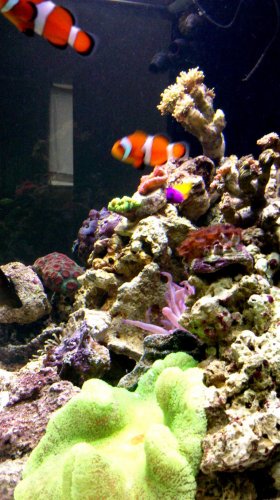tkilgour
Member
Ocellaris Clown Fish - 1.25" - 2 " = $14.00 each ( 1 pair remaining )
Maximum Length: 3.5 in.
Care Level: Easy
Family: Pomacentridae
Reef Compatibility: Excellent
Minimum Aquarium Size: 30 gal.
Range: Indo-Pacific
Diet: Omnivore
Water Conditions: 74-80° F; sg 1.020-1.025; pH 8.1-8.4
Send zip for shipping quote. Email [email protected] or call 513.509.0494
Notes: The Ocellaris Clownfish is often confused with the Percula Clownfish, which has a similar orange and white color scheme. The easiest way to tell them apart is to remember that the Percula Clownfish has thick bands of black between his white stripes while the Ocellaris Clownfish has only a thin black line along the edge of its stripes.
As with most clownfish the Ocellaris Clownfish is best kept singly unless a pair is introduced together. It may attack other clownfishes and nip at passive tank-mates who wonder near its host anemone or territory. Generally, it is a great fish for the reef aquarium and spends much of its time nestled peacefully in its anemone. If you plan to keep other clownfish, it is best to do it in a larger aquarium of 100 gallons or more and provide each clownfish, or pair of clownfish, with their own anemone. That way each fish has a comfortable home and quarrels will be reduced. Adding all of the clownfish at the same time will also help to reduce territorial disputes.
The Ocellaris Clownfish does not require a host anemone for survival; however it is a real treat for any hobbyist to observe the symbiotic relationship between the clownfish and its host anemone. The anemone provides a safe haven for the clownfish because its tentacles will inflict a painful sting on all but other clownfish. The clownfish, in return, chases off fish that threaten to pick at the anemone and brings it scraps of food. The Ocellaris Clownfish adapts to almost all common sea anemones, but prefers the Long Tentacle Anemone.
Feed a varied diet of frozen carnivore and herbivore preparations including mysid shrimp, brine shrimp, chopped marine flesh, marine algae, and sometimes krill for it to feed the anemone with.
Maximum Length: 3.5 in.
Care Level: Easy
Family: Pomacentridae
Reef Compatibility: Excellent
Minimum Aquarium Size: 30 gal.
Range: Indo-Pacific
Diet: Omnivore
Water Conditions: 74-80° F; sg 1.020-1.025; pH 8.1-8.4
Send zip for shipping quote. Email [email protected] or call 513.509.0494
Notes: The Ocellaris Clownfish is often confused with the Percula Clownfish, which has a similar orange and white color scheme. The easiest way to tell them apart is to remember that the Percula Clownfish has thick bands of black between his white stripes while the Ocellaris Clownfish has only a thin black line along the edge of its stripes.
As with most clownfish the Ocellaris Clownfish is best kept singly unless a pair is introduced together. It may attack other clownfishes and nip at passive tank-mates who wonder near its host anemone or territory. Generally, it is a great fish for the reef aquarium and spends much of its time nestled peacefully in its anemone. If you plan to keep other clownfish, it is best to do it in a larger aquarium of 100 gallons or more and provide each clownfish, or pair of clownfish, with their own anemone. That way each fish has a comfortable home and quarrels will be reduced. Adding all of the clownfish at the same time will also help to reduce territorial disputes.
The Ocellaris Clownfish does not require a host anemone for survival; however it is a real treat for any hobbyist to observe the symbiotic relationship between the clownfish and its host anemone. The anemone provides a safe haven for the clownfish because its tentacles will inflict a painful sting on all but other clownfish. The clownfish, in return, chases off fish that threaten to pick at the anemone and brings it scraps of food. The Ocellaris Clownfish adapts to almost all common sea anemones, but prefers the Long Tentacle Anemone.
Feed a varied diet of frozen carnivore and herbivore preparations including mysid shrimp, brine shrimp, chopped marine flesh, marine algae, and sometimes krill for it to feed the anemone with.

